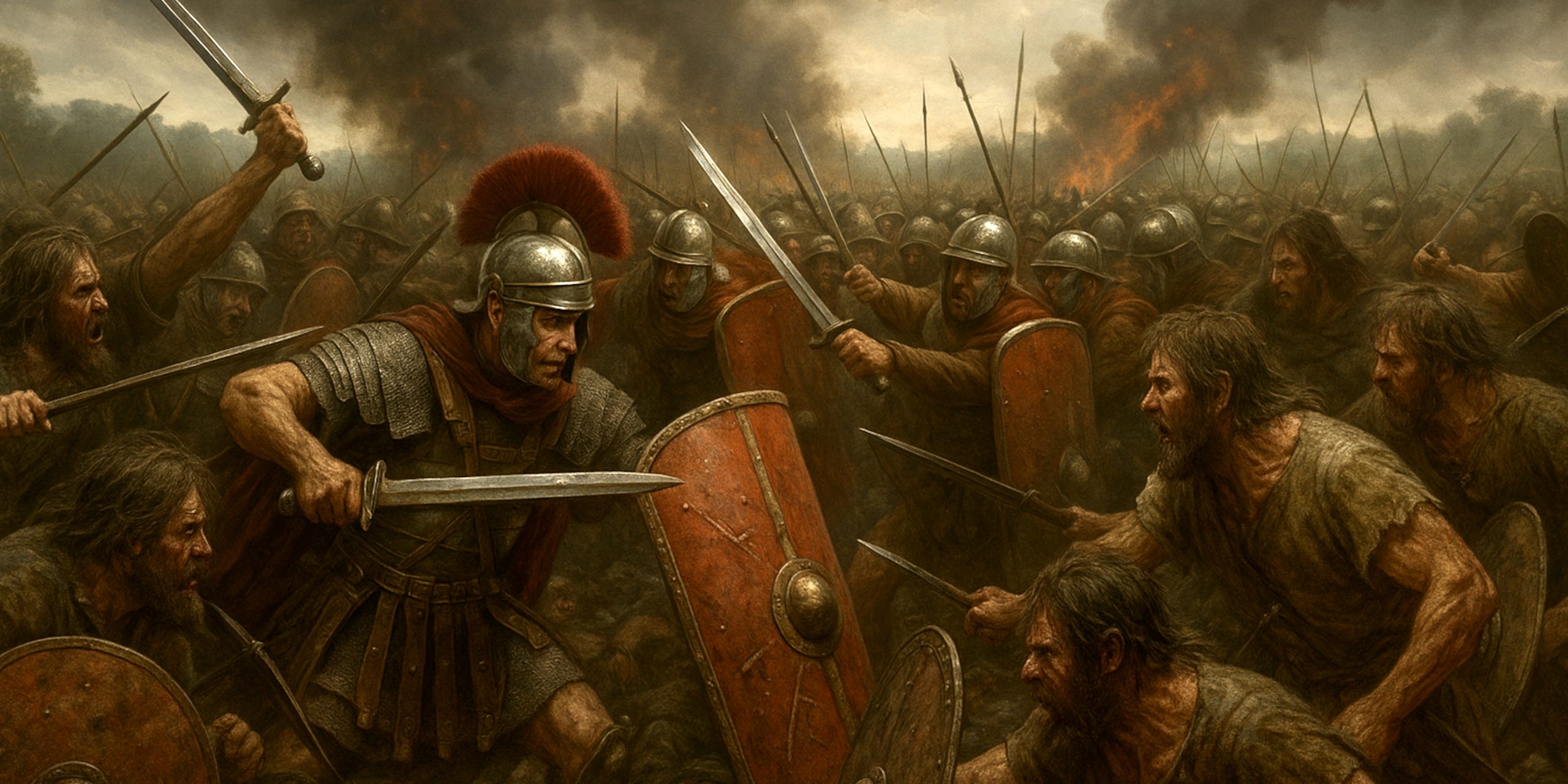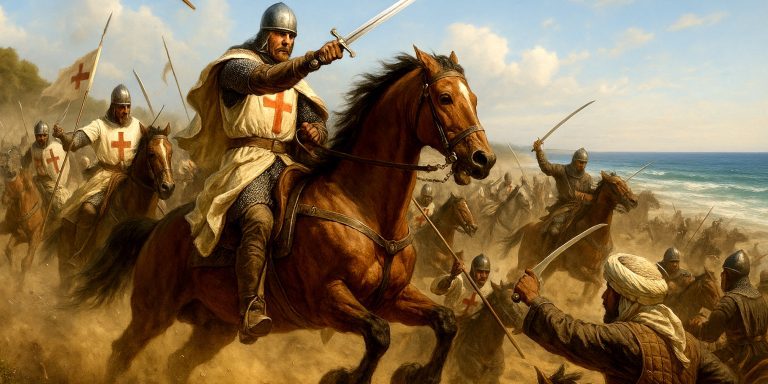
This article explores 25 of the most significant battles fought by the Roman Republic and Empire, tracing their consequences on military strategy, political power, and historical legacy. These battles, listed from later to earlier, span over a millennium of Roman warfare and illustrate how military success and failure shaped the rise and fall of Rome.
25. Battle of Mons Graupius (c. 83 AD)
Summary: Agricola defeated the Caledonian tribes in northern Britain.
- Commanders: Gnaeus Julius Agricola (Rome), Calgacus (Caledonians)
- Troops: ~17,000 Romans vs ~30,000 Caledonians
- Weapons: Gladii, pila, slings; Celtic longswords, oval shields
- Outcome: Roman victory
- Legacy: Marked the high point of Roman expansion into Scotland, though never fully secured.
24. Battle of the Medway (43 AD)
Summary: First major battle of the Claudian invasion of Britain.
- Commanders: Aulus Plautius (Rome), British tribal leaders
- Troops: ~40,000 Romans vs ~100,000 Britons
- Weapons: Gladii, pila, Roman cavalry; British spears, chariots
- Outcome: Roman victory
- Legacy: Opened the path to Roman rule in southern Britain.
23. Battle of Watling Street (60/61 AD)
Summary: Boudica’s rebellion was crushed by Suetonius.
- Commanders: Suetonius Paulinus (Rome), Boudica (Iceni)
- Troops: ~10,000 Romans vs ~100,000 Britons
- Weapons: Gladii, pila; British spears, slings
- Outcome: Decisive Roman victory
- Legacy: Ensured continued Roman control over Britain.
22. Siege of Masada (73 AD)
Summary: The final Jewish stronghold fell after prolonged siege.
- Commanders: Flavius Silva (Rome)
- Troops: ~15,000 Romans vs ~1,000 Jewish defenders
- Weapons: Siege ramps, ballistae, battering rams; Jewish guerrilla resistance
- Outcome: Roman victory
- Legacy: Became a symbol of resistance; marked the end of the First Jewish–Roman War.
21. Siege of Jerusalem (70 AD)
Summary: Titus captured and destroyed Jerusalem during the First Jewish Revolt.
- Commanders: Titus (Rome)
- Troops: ~70,000 Romans vs ~60,000 Jewish defenders and civilians
- Weapons: Siege towers, battering rams, ballistae
- Outcome: Roman victory
- Legacy: Destroyed the Second Temple; reshaped Jewish identity and Roman Judea.
20. Battle of the Colline Gate (82 BC)
Summary: Sulla secured Rome after defeating Samnite and Marian forces.
- Commanders: Lucius Cornelius Sulla (Rome), Pontius Telesinus
- Troops: ~40,000 on each side
- Weapons: Gladii, pila, heavy infantry
- Outcome: Roman victory
- Legacy: Established Sulla’s dictatorship and heralded the end of the Republic’s democratic structures.
19. Battle of Arausio (105 BC)
Summary: Rome suffered one of its worst defeats against the Cimbri and Teutones.
- Commanders: Mallius Maximus and Caepio (Rome), Boiorix (Cimbri)
- Troops: ~80,000 Romans vs ~100,000 Germanic tribes
- Weapons: Gladii, pila; axes, spears, longswords
- Outcome: Barbarian victory
- Legacy: Triggered major military reforms under Gaius Marius.
18. Battle of Alesia (52 BC)
Summary: Caesar’s masterpiece siege against Vercingetorix.
- Commanders: Julius Caesar (Rome), Vercingetorix (Gauls)
- Troops: ~50,000 Romans vs ~250,000 Gauls (including relief force)
- Weapons: Gladii, siege fortifications, cavalry
- Outcome: Roman victory
- Legacy: Ended major Gallic resistance; secured Gaul.
17. Battle of Gergovia (52 BC)
Summary: Caesar’s failed assault on Vercingetorix’s stronghold.
- Commanders: Julius Caesar (Rome), Vercingetorix (Gauls)
- Troops: ~25,000 Romans vs ~30,000 Gauls
- Weapons: Standard legionary arms; Gallic longswords and slings
- Outcome: Gallic victory
- Legacy: One of Caesar’s rare defeats; temporarily bolstered Gallic morale.
16. Battle of Pharsalus (48 BC)
Summary: Caesar decisively defeated Pompey in Greece.
- Commanders: Julius Caesar vs Pompey
- Troops: ~22,000 Caesar vs ~45,000 Pompeians
- Weapons: Gladii, pila, siege engines, cavalry
- Outcome: Caesar’s victory
- Legacy: Ended senatorial resistance and paved the way for dictatorship.
15. Battle of Philippi (42 BC)
Summary: Antony and Octavian crushed the assassins of Caesar.
- Commanders: Mark Antony and Octavian vs Brutus and Cassius
- Troops: ~100,000 on each side
- Weapons: Legionary arms, cavalry, siege elements
- Outcome: Triumvirate victory
- Legacy: End of Republican resistance; rise of Imperial Rome.
14. Battle of Carrhae (53 BC)
Summary: Crassus was lured and annihilated by Parthian cavalry.
- Commanders: Crassus (Rome), Surena (Parthia)
- Troops: ~43,000 Romans vs ~10,000 Parthians
- Weapons: Roman pila and gladii; Parthian horse archers, cataphracts
- Outcome: Parthian victory
- Legacy: Humiliated Rome; shifted balance in the East.
13. Battle of the Sabis (57 BC)
Summary: Caesar overcame a surprise attack from the Nervii.
- Commanders: Julius Caesar (Rome), Boduognatus (Nervii)
- Troops: ~40,000 Romans vs ~60,000 Nervii
- Weapons: Gladii, pila; Celtic longswords
- Outcome: Roman victory
- Legacy: Cemented Roman dominance in northern Gaul.
12. Battle of Cynoscephalae (197 BC)
Summary: Legion outclassed Macedonian phalanx.
- Commanders: Titus Quinctius Flamininus (Rome), Philip V (Macedon)
- Troops: ~25,000 each
- Weapons: Gladii vs sarissae (phalanx spears)
- Outcome: Roman victory
- Legacy: Confirmed Roman military supremacy in Greece.
11. Battle of Magnesia (190 BC)
Summary: Rome defeated the Seleucid Empire in Asia Minor.
- Commanders: Scipio Asiaticus (Rome), Antiochus III (Seleucid)
- Troops: ~30,000 Romans vs ~70,000 Seleucids
- Weapons: Gladii, pila, phalanx, scythed chariots
- Outcome: Roman victory
- Legacy: Reduced Seleucid power; expanded Roman hegemony east.
10. Battle of the Metaurus (207 BC)
Summary: Hasdrubal was killed bringing reinforcements to Hannibal.
- Commanders: Gaius Nero, Marcus Livius (Rome), Hasdrubal (Carthage)
- Troops: ~50,000 Romans vs ~30,000 Carthaginians
- Weapons: Gladii, Iberian swords, elephants
- Outcome: Roman victory
- Legacy: Saved Rome from two-front disaster; changed Second Punic War’s course.
9. Battle of Lake Trasimene (217 BC)
Summary: Hannibal ambushed and crushed Flaminius’ army.
- Commanders: Hannibal (Carthage), Flaminius (Rome)
- Troops: ~30,000 Romans vs ~50,000 Carthaginians
- Weapons: Roman heavy infantry; Carthaginian cavalry, Iberian steel
- Outcome: Carthaginian victory
- Legacy: Exemplified Hannibal’s tactical brilliance.
8. Battle of the Trebia (218 BC)
Summary: Hannibal’s first major victory on Italian soil.
- Commanders: Hannibal (Carthage), Tiberius Sempronius Longus (Rome)
- Troops: ~40,000 each
- Weapons: War elephants, cavalry ambushes
- Outcome: Carthaginian victory
- Legacy: Cemented Hannibal’s presence in Italy.
7. Battle of Ilipa (206 BC)
Summary: Scipio outmanoeuvred and defeated Carthaginian forces in Spain.
- Commanders: Scipio Africanus, Hasdrubal Gisco
- Troops: ~48,000 Romans vs ~70,000 Carthaginians
- Weapons: Roman and Iberian mix
- Outcome: Roman victory
- Legacy: Secured Iberia and cut off Hannibal’s resources.
6. Battle of Pydna (168 BC)
Summary: Rome crushed the last Macedonian phalanx.
- Commanders: Lucius Aemilius Paullus vs Perseus of Macedon
- Troops: ~30,000 each
- Weapons: Gladii vs sarissae
- Outcome: Roman victory
- Legacy: Ended Macedonian independence.
5. Battle of Cannae (216 BC)
Summary: Hannibal encircled and obliterated the largest Roman army ever fielded.
- Commanders: Hannibal vs Varro and Paullus
- Troops: ~86,000 Romans vs ~50,000 Carthaginians
- Weapons: Gladii, Iberian swords, heavy cavalry
- Outcome: Carthaginian victory
- Legacy: Tactical benchmark; Rome adapted by avoiding direct battle.
4. Battle of Zama (202 BC)
Summary: Scipio decisively defeated Hannibal in Africa.
- Commanders: Scipio Africanus vs Hannibal
- Troops: ~35,000 Romans vs ~40,000 Carthaginians
- Weapons: Roman infantry, Numidian cavalry
- Outcome: Roman victory
- Legacy: Ended the Second Punic War; Carthage was no longer a threat.
3. Battle of Actium (31 BC)
Summary: Octavian’s fleet defeated Antony and Cleopatra.
- Commanders: Marcus Agrippa (for Octavian) vs Antony and Cleopatra
- Troops: ~400 Roman ships vs ~500 Egyptian-allied ships
- Weapons: Ballistae, ramming ships, fire arrows
- Outcome: Octavian’s victory
- Legacy: Ended civil war; Octavian became Augustus and established the Roman Empire.
2. Battle of the Allia (390 BC)
Summary: Rome’s catastrophic defeat by the Gauls.
- Commanders: Brennus vs Roman consuls
- Troops: ~15,000 Romans vs ~30,000 Gauls
- Weapons: Roman spears, shields; Gallic swords, slings
- Outcome: Gallic victory
- Legacy: Rome was sacked; led to military reforms and the development of the manipular legion.
1. Battle of the Teutoburg Forest (9 AD)
Summary: Germanic tribes ambushed and destroyed three Roman legions.
- Commanders: Arminius (Germans) vs Varus (Rome)
- Troops: ~20,000 Romans vs ~30,000 Germans
- Weapons: Roman gladii, spears; German axes, guerrilla tactics
- Outcome: German victory
- Legacy: Permanently halted Roman expansion east of the Rhine.



